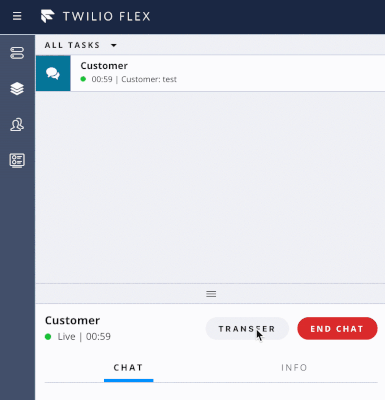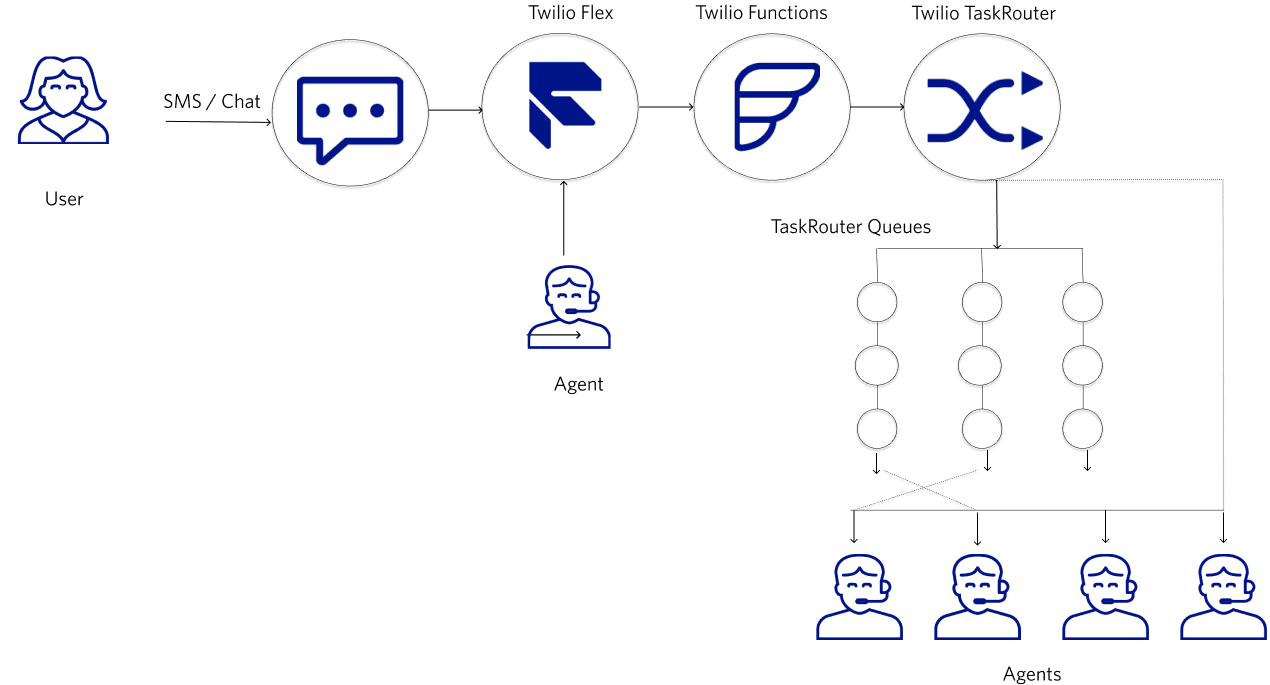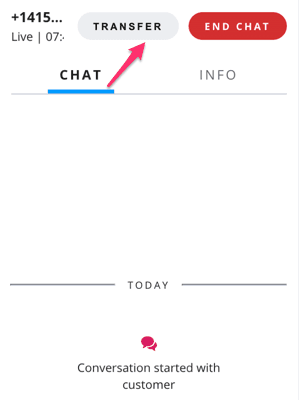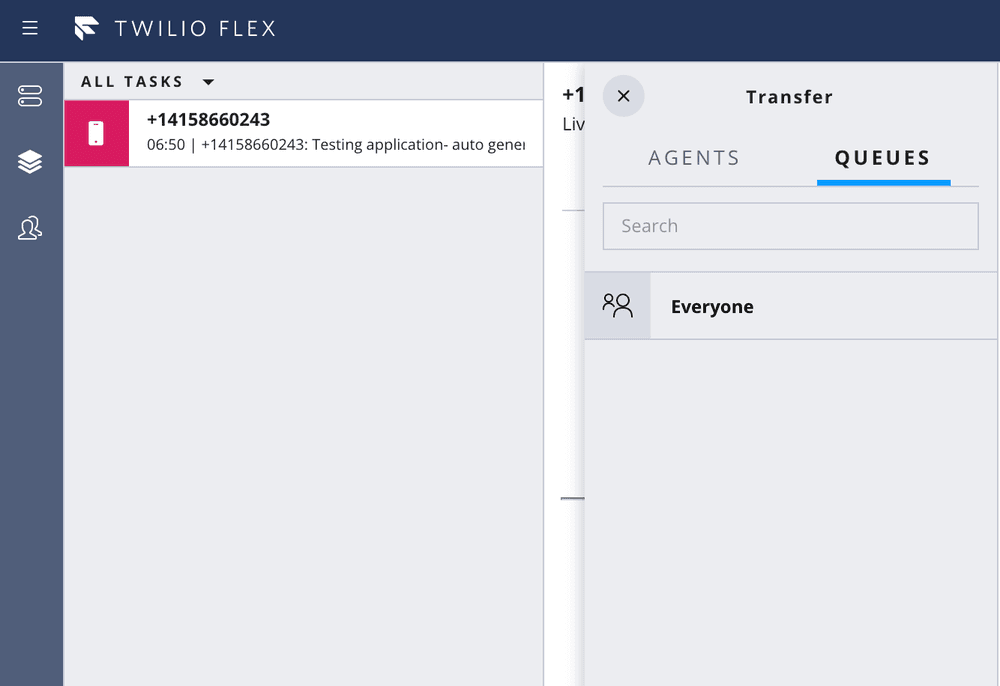Chat and SMS Transfers (Flex UI 1.x.x)
Pre-built Chat Transfer plugin is available in Flex UI 2.x.x
This guide is only for Flex UI 1.x.x, which reached End of Life on June 30, 2024. To build on a current version, we recommend you upgrade to Flex UI 2.x.x and install the ready-to-use Chat Transfer plugin. You must be logged in to Twilio Console to access the Flex Plugin Library.
Warning
This solution features sample code that is provided "as is" and is not production grade. The featured code does not account for edge case handling, scalability, and reliability. It is not covered under Twilio's Service Level Agreement (SLA) and support plans.
The Chat and SMS Transfer solution helps contact center administrators transfer Chats and SMS between Agents. When a customer is interacting with an Agent via Chat or SMS, they can be transferred to another agent or to a queue of agents. This solution supports "cold" chat or SMS transfers.


To deploy this solution, you will need:
-
An active Twilio account with Flex provisioned. Refer to the Flex Quickstart to create one.
-
npmversion 6.0.0 installed (typenpm -vin your terminal to check). -
A Node.js long-term-support (LTS) version installed, version 14 recommended (type
node -vin your terminal to check). -
Twilio CLI along with the Flex CLI Plugin and the Serverless Plugin. Run the following commands to install them:
1# Install the Twilio CLI2npm install twilio-cli@2.0 -g3# Install the Serverless and Flex as Plugins4twilio plugins:install @twilio-labs/plugin-serverless5twilio plugins:install @twilio-labs/plugin-flex
Info
If you're running Linux, click on the Linux tab for the Twilio CLI installation instructions. If you're running Windows, make sure to run the Windows command prompt as an administrator to install the Serverles/Flex plugins for the Twilio CLI. The Windows commands in this guide use PowerShell (for Node.js/npm installation).
30 minutes
- Flex v1.18.1-1.30.0
- macOS/Linux
- Windows 10
In order to use the solution, you need to prepare your Flex Task Assignment workspace.
Navigate to your Flex project in the Twilio Console. Copy your ACCOUNT SID and AUTH TOKEN, and create a new Twilio CLI profile using those credentials:
twilio profiles:create
You will be prompted to enter your Twilio Account SID, Auth Token, and a shorthand identifier for your profile. When choosing a shorthand identifier, pick one that is meaningful and that you can remember. Once your profile has been created, activate it by running:
twilio profiles:use PROFILE_ID
Keep in mind that this account will be used for the rest of the deployment. In order to switch accounts, use the following command:
twilio profiles:use DIFFERENT_PROFILE_ID
Retrieve your Flex Task Assignment workspace SID:
1twilio api:taskrouter:v1:workspaces:list2
Example workspace SID
1SID Friendly Name Prioritize Queue Order2WSXXXXXXXXXXXXXXXXXXXXXXXXXXXXXXXX Flex Task Assignment FIFO3
To retrieve your Flex workspace SID from the Twilio Console, navigate to the TaskRouter Dashboard.
Retrieve the unique IDs (or SIDs) of the queues you wish to associate with your Chat Transfer workflow. Copy these values for the next step.
twilio api:taskrouter:v1:workspaces:task-queues:list --workspace-sid WSXXXXXXXXXXXXXXXXXXXXXXXXXXXXXXXX
Example task queue SID
1SID Friendly Name Task Order2WQXXXXXXXXXXXXXXXXXXXXXXXXXXXXXXXX Everyone FIFO345To retrieve your Flex task queue SID from the Twilio Console, navigate to TaskRouter > Flex Task Assignment > TaskQueues.
To create a new workflow, run the following command in your terminal. Replace the task queue and workspace SID placeholders with the SIDs you retrieved in the previous steps.
1CONFIGURATION=$(cat << EOF2{3"task_routing": {4"filters": [5{6"filter_friendly_name": "Worker Filter",7"expression": "transferTargetType == 'worker'",8"targets": [9{10"queue":"WQXXXXXXXXXXXXXXXXXXXXXXXXXXXXXXXX",11"expression":"worker.sid == task.targetSid"12}13]14},15{16"filter_friendly_name": "Sales Queue",17"expression": "transferTargetType == 'queue' AND targetSid == 'WQYYYYYYYYYYYYYYYYYYYYYYYYYYYYYYYY'",18"targets": [19{20"queue":"WQYYYYYYYYYYYYYYYYYYYYYYYYYYYYYYYY"21}22]23},24{25"filter_friendly_name": "Support Queue",26"expression": "transferTargetType == 'queue' AND targetSid == 'WQZZZZZZZZZZZZZZZZZZZZZZZZZZZZZZZZ'",27"targets": [28{29"queue":"WQZZZZZZZZZZZZZZZZZZZZZZZZZZZZZZZZ"30}31]32}33],34"default_filter": {35"queue": "WQXXXXXXXXXXXXXXXXXXXXXXXXXXXXXXXX"36}37}38}39EOF40)4142twilio api:taskrouter:v1:workspaces:workflows:create --workspace-sid WSXXXXXXXXXXXXXXXXXXXXXXXXXXXXXXXX --friendly-name "Chat Transfers" --configuration "$CONFIGURATION"43
Example workflow confirmation
1SID Friendly Name Document Content Type2WWXXXXXXXXXXXXXXXXXXXXXXXXXXXXXXXX Chat Transfers null
For more details on expected workflow settings, see Plugin Details. To learn about configuring more complex workflows, see Create a Workflow Resource and Configuring Workflows: Complex Routing Example.
Download the plugin source code and unzip the files in a local directory.
We will deploy the Chat/SMS Transfer function to your Flex instance. The function is called from the plugin you will deploy in the next step and integrates with TaskRouter, passing in required attributes to perform the chat transfer.
Step 1: Change into the functions directory and rename .env.example.
1cd ~/plugin-chat-sms-transfer/functions2mv .env.example .env
Step 2: Open .env and set the environment variables mentioned in the file.
1TWILIO_ACCOUNT_SID = your Account SID from twil.io/console2TWILIO_AUTH_TOKEN = your Auth Token from twil.io/console3TWILIO_WORKSPACE_SID = your Flex Task Assignment workspace ID4TWILIO_CHAT_TRANSFER_WORKFLOW_SID=your Flex Workflow ID
Step 3: Deploy the Twilio function to your account using the Twilio CLI:
twilio serverless:deploy
Info
When running on Windows, you may see an error with the Twilio Serverless deployment command. To work around the issue, set your TWILIO_ACCOUNT_SID and TWILIO_AUTH_TOKEN as environment variables. Refer to the previous section for examples of how to set an environment variable in Windows.
Step 2: Open .env and set the environment variables mentioned in the file.
1TWILIO_ACCOUNT_SID = your Account SID from twil.io/console2TWILIO_AUTH_TOKEN = your Auth Token from twil.io/console3TWILIO_WORKSPACE_SID = your Flex Task Assignment workspace ID4TWILIO_CHAT_TRANSFER_WORKFLOW_SID=your Flex Workflow ID
Step 3: Deploy the Twilio function to your account using the Twilio CLI:
twilio serverless:deploy
Info
Debugging tip: pass the -l or logging flag to review deployment logs. For example, you can pass -l debug to turn on debugging logs.
Once you have deployed the function, you can deploy the plugin to your Flex instance. Run the following commands in the plugin directory. We will leverage the Twilio CLI to build and deploy the plugin:
1npm install2
You need to modify the source file to mention the Serverless domain of the function that you deployed previously. In the root plugin directory, rename .env.example:
cp .env.example .env
Open .env with your text editor and set the environment variables listed in the file:
1# Paste the Function deployment domain2REACT_APP_FUNCTION_DOMAIN='https://plugin-chat-sms-transfer-functions-xxxx-dev.twil.io';
When you are ready to deploy the plugin, run the following in a terminal:
twilio flex:plugins:deploy --major --changelog "Update the plugin to use Builder v4" --description "Chat and SMS Cold Transfers in Flex"
Example plugin deployment output
1✔ Validating deployment of plugin plugin-chat-sms-transfer2⠧ Compiling a production build of plugin-chat-sms-transferPlugin plugin-chat-sms-transfer was successfully compiled with some warnings.3✔ Compiling a production build of plugin-chat-sms-transfer4✔ Uploading plugin-chat-sms-transfer5✔ Registering plugin plugin-chat-sms-transfer with Plugins API6✔ Registering version v1.0.0 with Plugins API78🚀 Plugin (private) plugin-chat-sms-transfer@1.0.0 was successfully deployed using Plugins API
The previous step only deploys your plugin — you still need to enable it for your Flex application. To do so, run:
twilio flex:plugins:release --plugin plugin-chat-sms-transfer@1.0.0 --name "Chat and SMS Transfers" --description "Enabling chat and SMS transfers using Solution Guide"
Now navigate to the Plugins Dashboard to review your recently deployed plugin and confirm that it's enabled for your contact center.
You are all set to test Chat and SMS Transfers on your Flex application!
Warning
Keep in mind that your Agents need to refresh their browsers in order to get the latest changes.
Step 1: Log in as an admin to your Flex instance where you deployed the plugin.
Step 2: Change your status to Available in the upper right corner of the Flex UI. This enables you to receive incoming calls and messages (SMS or chat).
Step 3: To test SMS transfer in Flex, send a text to the number associated with your Flex instance. You can find the Twilio-provisioned number for your Flex instance on the Admin panel under Test Drive.
Step 4: To test chat transfer, click Launch (on the Admin panel) to launch the Flex web chat widget. This will open up a new tab where you can enter a test message.
Step 5: To see the incoming text or chat request, navigate to the Agent Desktop in your Flex Instance.
Step 6: Upon clicking Accept, you should now see a Transfer button next to End Chat:

Step 7: Click Transfer to initiate a transfer. You have the option to either transfer the chat to another Agent (in the Agents tab) or reassign the chat to a queue of Agents (in the Queues tab).
Step 8: Click the Right Arrow icon to perform a cold transfer. This autocompletes the initial chat task for the Agent who initiated the transfer, and creates a new chat task for the Agent receiving the transfer.
